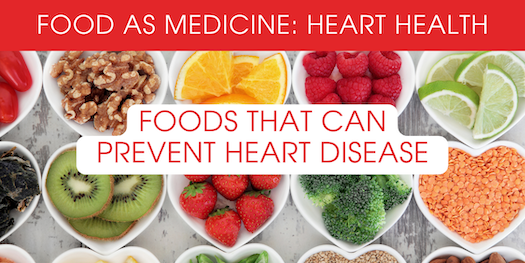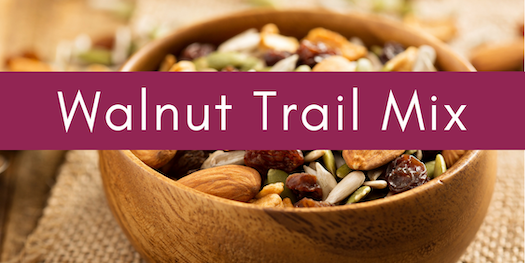February is all about hearts. Not only is it the month of Valentine's day, but it is also American Heart Health Month. Your heart beats about 100,000 times and pumps 2,000 gallons of blood daily.
Did you know that if your blood vessels were laid out end-to-end, they would measure about 60,000 miles? That's twice the circumference of the earth!
Together your heart and blood vessels make up your body's cardiovascular system.
That's why this month, we're focusing on things you can do to keep your heart and cardiovascular system healthy. The main article focuses on five foods to include in your daily eating. The mini-article has five bonus tips for keeping your cardiovascular system working great.
-Stephanie
|
|
|
Food As Medicine: Heart Health
|

Leafy greens: Including leafy greens in helps your meals helps you consume a variety of vitamins, minerals, and antioxidants. Leafy greens also provide a natural source of nitrates, a natural chemical found in soil, air and water; nitrates that are naturally found in vegetables, are a vital component for health and well-being. Nirates from vegetables help reduce blood pressure, keep your arteries flexible, and help keep the cells that link the blood vessels healthy.
How to do it: Include a serving of green leafy vegetables in at least one daily meal. Some ideas include a green salad with lunch or dinner, adding kale or spinach to your smoothie, topping your sandwich with a handful of dark leafy greens, or adding to your morning eggs.
Pro Tip: Leafy greens are rich in vitamin K, which helps with blood clotting. Maintaining a consistent intake of Vitamin K-containing foods for people on blood thinners is recommended. Therefore, you want to avoid suddenly adding or taking out leafy greens. If you are on a blood thinner, talk with your doctor about eating leafy greens.
Avocados: Rich in monounsaturated fats and potassium, avocados support a healthy heart. Not only are monounsaturated fats associated with reducing cholesterol levels, but potassium helps to reduce blood pressure.
How to do it: Add avocado to a salad or smoothie, enjoy it with your morning eggs, or experiment with making avocado chocolate pudding!
Pro Tip: To quickly ripen avocados: place them in a brown paper bag and fold it to seal. The release of ethylene gas, a plant hormone that aids ripening, will help speed up the ripening process.
Walnuts: Magnesium, copper, manganese, and fiber are all present in walnuts and are beneficial to your cardiovascular system. Some research shows that walnuts can help prevent cardiovascular disease. Walnuts may also help reduce cholesterol levels and blood pressure.
How to do it: Add a handful of walnuts to a salad or with berries as a snack.
Pro Tip: Store walnuts in the freezer to keep them fresh and extend their shelf life.
Garlic: The component responsible for the distinctive odor in garlic, allicin, is also what makes garlic good for your heart! Allicin reduces inflammation and supports lower blood pressure and cholesterol levels.
How to do it: To get the full benefits of the allicin in garlic, crush or chop it and let it sit for 10 minutes before cooking.
Pro Tip: Fresh garlic is always best but if you are considering taking allicin as a supplement, be aware that side effects from taking too much can include: garlic breath, belching, gas, nausea, diarrhea, and heartburn.
Green Tea Extract: Filled with antioxidants, green tea may help reduce inflammation and protect your heart. Green tea extract may lower blood pressure, triglycerides, LDL, and total cholesterol.
How to do it: Opt for whole tea leaves such as matcha to reap the maximum benefits from green tea.
Pro Tip: If you choose a green tea extract supplement, check the supplement facts panel to be sure you know everything it contains. Also, look for a GMP symbol to help you know it was manufactured using "good manufacturing practices."
|
|
|
Beyond Food: Lifestyle Choices for a Healthy Heart
|
 Get active. The health benefits of regular, moderate physical activity are endless! Start by doing what you can, at least 10 minutes at a time. You don't have to do an hour-long killer workout each day; taking a brisk walk also counts! Always check with your physician before beginning a workout regimen. Get active. The health benefits of regular, moderate physical activity are endless! Start by doing what you can, at least 10 minutes at a time. You don't have to do an hour-long killer workout each day; taking a brisk walk also counts! Always check with your physician before beginning a workout regimen.
- Quit smoking and avoid secondhand smoke. Smoke from cigarettes and vaping is harmful to your heart.
- Manage your stress. Stress is a significant contributor to heart disease. Exercise, meditation, journaling, proper nutrition, and healthy sleep habits are good ways to manage stress. Stop and take a few deep breaths when you're feeling anxious or stressed. Practice paying attention to how you're feeling and what is going on with your body.
- Reduce sugar intake. The American Heart Association gives the following recommendations for daily sugar intake: men: 36 grams, or nine teaspoons; women: 25 grams, or six teaspoons and children: 12 grams, or three teaspoons.
- Limit alcohol intake. If you drink, do so in moderation. Current recommendations are up to two drinks per day for men and one drink per day for women. One drink is equivalent to 12 oz beer, 5 oz wine, or 1.5 oz hard liquor. While some studies have found health benefits associated with moderate alcohol consumption, it is essential to remember that moderation is key. Health risk significantly rises with more than two drinks per day for men or more than one drink per day for women.
- Eat less salt. The goal is to keep it under 2,300 mg each day. More salt in your diet can lead to high blood pressure, which affects your heart. Eat less salt by preparing foods at home and limiting added salt used in cooking. You can easily cut at least half the salt from most recipes and enhance flavors with herbs and spices. As you shop, select reduced-sodium or no-salt-added canned soups and vegetables.
- Explore cholesterol lowering supplements. Discuss with your healthcare team if including Chinese red-yeast rice, fish oils, and fiber supplements (such as psyllium husk) would be beneficial for you and your goals.
|
|
Featured Recipe
Walnut Trail Mix
|

This walnut trail mix has the heart-healthy goodness of omega-3s and other nutrients that make this an optimal high-energy snack for people on the go!
Ingredients:
2 cups California walnut halves
1 cup unsalted pumpkin seeds
1 cup dried cranberries
1 cup chopped dried apricots
1 cup banana chips
1/2 cup goji or acai berries (optional)
Directions:
Preheat oven to 350°F. Arrange walnuts in a single layer on a large rimmed baking sheet.
Bake in the center of the oven until fragrant and toasted, about 8 to 10 minutes.
Let cool. In a large container, combine toasted walnuts with pumpkin seeds, dried cranberries, apricots, banana chips and acai berries (if using). Store in an airtight container for up to 5 days.
Makes 12 servings
Nutrition facts per ½ cup: 265 calories, 13 grams fat, 2.5 gram saturated fat, 2 grams monounsaturated fat, 10 mg sodium, 22 grams carbohydrates, 3 grams fiber, 7 grams protein
|
|
|
Be Inspired
|
|

|
|
|
About SO Nutrition
|
 Stephanie Leipprandt Ouellette, MBA, RDN, LD
Stephanie Leipprandt Ouellette, MBA, RDN, LD Stephanie has been working in the field of nutrition and dietetics since 1995. She earned a Bachelor of Science degree in Dietetics from Michigan State University, completed an Approved Pre-Professional Practice Program at Western Michigan University and earned a Master of Business Administration from Baker College. She’s been a Registered Dietitian Nutritionist since 1996 and licensed in Texas since 2007. In 2008, Stephanie earned her certification in Childhood and Adolescent Weight Management. Stephanie has extensive clinical & managerial experience, both in corporate settings and in the community. Now she wants to share her knowledge with you, because most (if not all) nutritional habits begin at home.
Stephanie and her family reside in Katy, Texas
|
|
| |
Copyright © 2023 Customized Nutrition Newsletters, All rights reserved.
|
|
| |
|
|